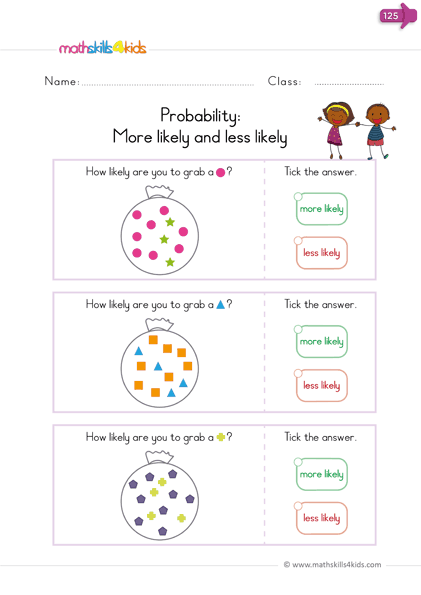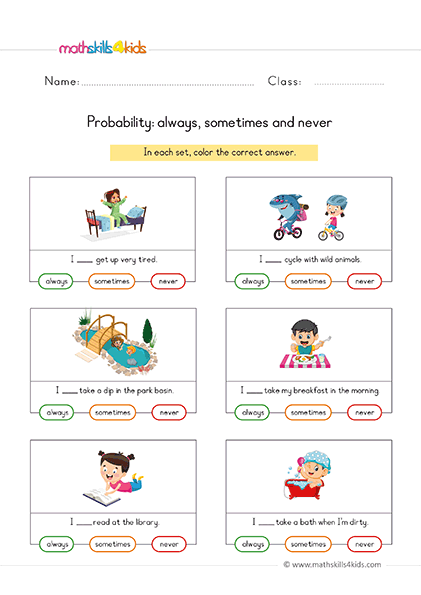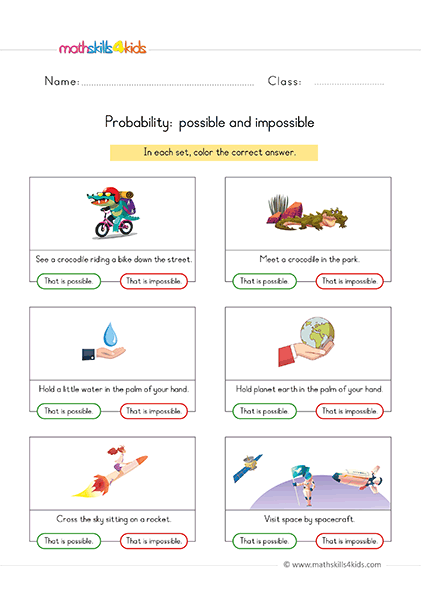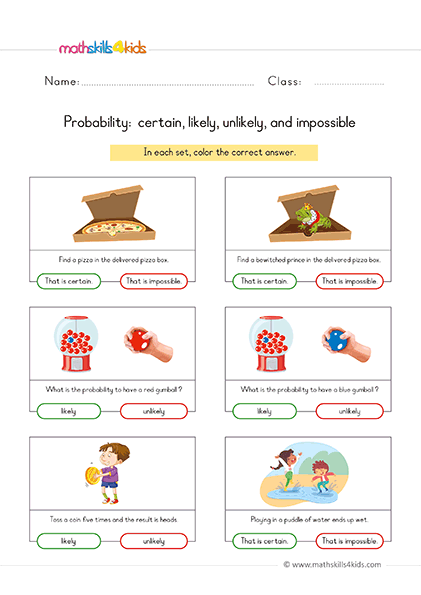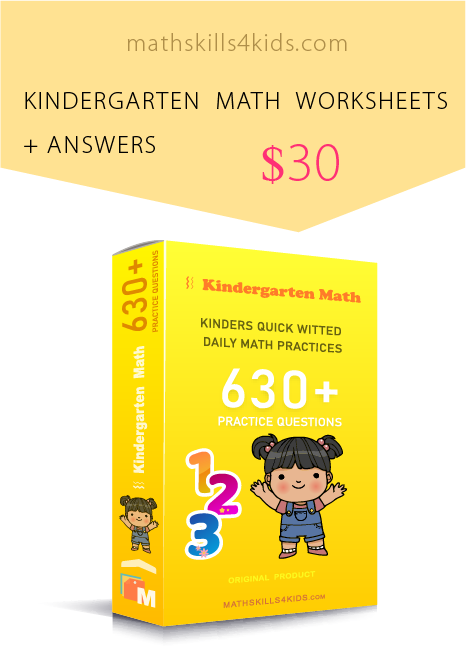Probability Worksheets for Kindergarten and Fun Activities for Kids
Hello, and welcome to this amazing resource! Today we'll share some fun and easy-to-solve probability worksheets for kindergarten students. Generally, we use probability to determine what is likely, unlikely, certain, possible, or impossible to happen.
This resource aims to make learning probability concepts easy and enjoyable for your kids. You'll find many engaging hands-on probability activities that will help kids learn how to make reasonable predictions.
-
Equally, recall that probability is the chance of something happening. For example, if you flip a coin, there is a 50% chance of getting heads and a 50% chance of getting tails.
Probability can be expressed as words, numbers, fractions, or percentages. Probability is an important math skill that helps us make decisions and predictions based on data and evidence.
Engaging probability activities for kinders: always, sometimes, never, likely, unlikely, certain, possible, and impossible
Do you need some fun, engaging probability activities for your classroom? If yes, then give your kinders a head start by first introducing what the concept is all about.
One way to introduce probability to young children is to use the terms: always, sometimes, never, likely, unlikely, certain, possible, and impossible. These words are essential for describing how likely something is to happen or not happen. For example, it is certain that the sun will rise tomorrow, but it is unlikely that it will snow in summer.
To make these words more concrete and meaningful for your kinders, you can use some simple and fun activities that involve everyday objects and situations.
Let's move on with mastering these basic probability activities.
-
BROWSE THE WEBSITE
-
DOWNLOAD FREE WORKSHEETS
-
-
K- MATH TOPICS
- Learn to count up to 3
- Counting from 1 to 5
- Count up to 10
- Learn to count up to 20
- Counting to 100
- Skip counting
- Measurement
- Sum and difference
- Comparison
- Patterns
- Addition up to 5
- Addition up to 10
- Subtraction up to 5
- Subtraction up to 10
- 2D shapes
- Introduction to symmetry
- Position
- Fractions
- Time
- Classify
- Data and graph
- Probability
- 3D shapes
-
-
What is probability?
Do you like playing games? Games can be fun and exciting, but sometimes they can also be hard to predict. For example, when you roll a dice, you don't know what number will come up. Maybe it will be a 1, or maybe it will be a 6. How can we talk about how likely something is to happen in a game?
We can use a word called probability. Probability is a way of measuring how often something happens out of all the possible outcomes. For example, if you roll a dice, there are 6 possible outcomes: 1, 2, 3, 4, 5, or 6. Each outcome has the same probability of happening, which is 1 out of 6. This means that for every 6 times you roll the dice, you can expect to get one of each number on average.
Probability can help us make smart choices and have fun with games!
-
Activity 1: Sorting objects by likelihood
For this sorting objects by likelihood activity, you will need a set of cards with pictures of different objects or events on them. You will also need a large sheet of paper with four columns labeled as certain, more likely, less likely, and impossible.
This activity aims to sort the cards into the appropriate columns based on how likely they are to happen. For example;
A card with a picture of a sunny day would go in a certain column because it is sure to happen at some point, Whereas a card with a picture of a snowman would go in the less likely column. After all, it is unlikely to happen in most places.
Moreover, a card with a picture of a unicorn would go in the impossible column because it is unreal and cannot happen.
To play this activity, shuffle the cards and place them face down in a pile. Have one student draw a card and show it to the group. Ask the student to explain why they think the event on the card is certain, more likely, less likely, or impossible. Then have them place the card in the corresponding column on the paper. Repeat until all cards are sorted.
This activity helps students develop their reasoning skills and understanding of probability as a measure of likelihood.
It also exposes them to scenarios and situations they may encounter in real life or stories.
-
Activity 2: Making predictions with spinners
You will need a set of spinners to make predictions for this activity. These spinners must be designed with different sections colored in different colors. You will also need a recording sheet for each student.
This activity aims to make predictions about what color the spinner will land on when it is spun and then test those predictions by spinning the spinner and recording the results. For example;
If a spinner has three sections colored red, blue, and green, a student might predict it will land on red more often than blue or green because red takes up more space.
To play this activity, have each student choose a spinner and place it on their desk. Have them look at the spinner and write their prediction on their recording sheet using words like more likely, less likely, equally likely, certain, or impossible. For example, they might write, "I think it is more likely to land on red."
Then have them spin the spinner 10 times and record each outcome using tally marks or symbols. After spinning 10 times, have them count how many times each color appeared and write down their results using numbers or fractions. For example, they might write, "It landed on red 6 times out of 10." Then have them compare their prediction with their results and write down whether their prediction was correct or not.
This activity helps students practice making predictions based on data and evidence and testing those predictions by conducting experiments. It also helps them learn how to record and interpret data using different representations such as words, numbers, fractions, symbols, and tally marks.
-
Activity 3: Comparing more likely and less likely events
For this activity, you will need a set of cards with two events written on each card to compare more likely or less likely events. You can use the cards we have created here (link) or make your own. You will also need two baskets or containers labeled more likely and less likely.
This activity aims to compare two events on each card and decide which one is more likely or less likely to happen. For example, a card might say, "Eating ice cream or broccoli for breakfast."
A student would choose which event is more likely to happen (eating ice cream) and which one is less likely to happen (eating broccoli) and place the card in the corresponding basket.
To play this activity, shuffle the cards and place them face down in a pile. Have one student draw a card and read it aloud to the group. Have them explain why they think one event is more likely or less likely than the other using words like more often, less often, usually, rarely, sometimes, never, etc. Then have them place the card in the appropriate basket. Repeat until all cards are sorted.
This activity helps students compare and contrast different events based on their likelihood and use comparative language to express their opinions and reasons.
Review and practice: Probability exercises for kindergarten
Here are five probability exercises you can do with your kindergarteners to help them understand more likely and less likely scenarios. You will need some simple materials like coins, dice, cards, marbles, or anything with different outcomes.
- Coin Toss: Give each child a coin and ask them to toss it in the air and catch it. Ask them what they got: heads or tails. Then ask them if it is more likely or less likely that they will get heads again if they toss the coin again.
Explain that each toss is independent of the previous one, so the probability of getting heads or tails is always 50%. Repeat this exercise several times and record the results on a chart or a graph.
- Dice Roll: Give each child a dice and ask them to roll it on a flat surface. Ask them what number they got and write it down. Then ask them if it is more likely or less likely that they will get the same number again if they roll the dice again.
Explain that each roll is independent of the previous one, so the probability of getting any number is always one out of six. Repeat this exercise several times and record the results on a chart or a graph.
- Card Draw: Give each child a deck of cards and ask them to shuffle it well. Ask them to draw one card from the top and show it to you. Ask them what suit and rank they got and write it down. Then ask them if it is more likely or less likely that they will get the same suit or rank again if they draw another card from the deck.
Explain that each draw depends on the previous one, so the probability of getting any suit or rank changes as cards are removed from the deck. Repeat this exercise several times and record the results on a chart or a graph.
Marble Grab: Give each child a bag of marbles of different colors and ask them to count how many marbles of each color are in the bag. Write down the numbers on a board or a piece of paper. Then ask each child to close their eyes and grab one marble from the bag without looking.
Ask them what color they got and write it down. Then ask them if it is more likely or less likely that they will get the same color again if they grab another marble from the bag without looking.
Explain that each grab depends on the previous one, so the probability of getting any color changes as marbles are removed from the bag. Repeat this exercise several times and record the results on a chart or a graph.
Weather Forecast: Show your kids a weather forecast for your area for the next week and ask them to look at the symbols for sunny, cloudy, rainy, snowy, etc. Ask them what kind of weather they think is more likely or less likely for each day based on the forecast.
Explain that weather forecasts are predictions based on data and models, but they are not always accurate, so there is some uncertainty involved in probability.
Finally, ask your kids to compare their predictions with the actual weather at the end of each day and see how close they were.
-
Thank you for sharing the links of MathSkills4Kids.com with your loved ones. Your choice is greatly appreciated.
We hope you enjoyed these exercises and learned something new about probability with your kids! Probability is a fun and useful topic that can help us make decisions and understand our world better. Stay tuned for more math activities from MathSkills4Kids!
Happy prediction!
Useful links
Teaching Probability in Kindergarten | A Pinch of Kinder :
http://www.apinchofkinder.com/2016/05/teaching-probability-in-kindergarten.html
A fun way to introduce your kids to the concept of probability | Gift of Curiosity :
https://www.giftofcuriosity.com/a-fun-way-to-introduce-your-kids-to-the-concept-of-probability/
